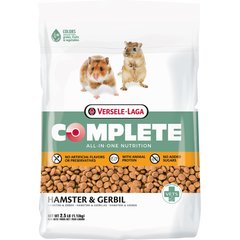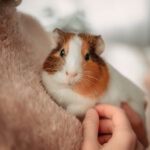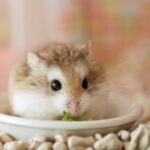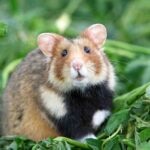Can Hamsters Eat Cheese?
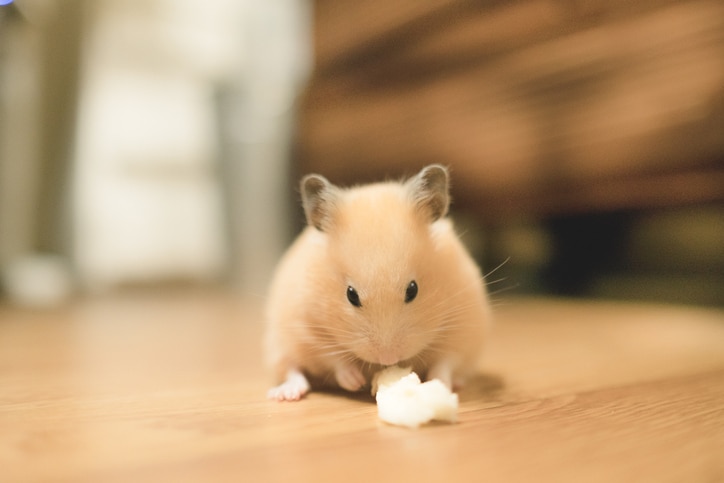
Photo by liebre / iStock / Getty Images Plus
Curious about what hamsters can eat and whether cheese is a safe treat? According to avian and exotic veterinarian Dr. Susan Tyson, VMD, MS, hamsters are omnivores, meaning their diet should include a healthy mix of veggies, fruits, and even insects.
So, the big question is—can hamsters eat cheese? Whether you’re considering offering a nibble as a treat or have a little one eager to share a snack from their plate, here’s what you need to know.
Can Hamsters Eat Cheese?
Unlike many other mammals, hamsters are not lactose-intolerant. In fact, one study even describes hamsters as having an “unusual tolerance for lactose.”
So while they can digest milk, does that mean cheese is safe?
“Hamsters can be fed cheese in moderation,” says Dr. Renee Schmid, DVM, DABT, DABVT, a senior veterinary toxicologist and director at the Pet Poison Helpline.
However, not all cheeses are made the same. Aged cheeses made with Penicillium mold, like blue cheese, might be harmful to hamsters, while soft cheeses are high in fat, making them an unhealthy choice.
These hard and non-moldy cheeses are generally safe for hamsters in small amounts:
- Cheddar
- Colby
- Swiss
- Monterey Jack
- Parmesan
- Cottage cheese
Avoid feeding your hamster moldy, soft, or flavored cheeses, such as:
- Blue cheese
- Brie
- Camembert
- Feta
- Any cheese with added garlic, onions, or raisins
How Much Cheese Can You Give To Your Hamster?
When it comes to giving treats to your hamster, a little goes a long way.
These small pets only eat about 12 grams of food per day, Dr. Schmid says. With such limited space, it’s important to prioritize nutritionally complete food, rather than letting your little friend fill up on treats.
Recommended Product
While cheese can be a fun snack, it should only be given in tiny amounts—two to three grams at a time, at most—and only a few times a week to maintain a balanced diet, Dr. Schmid says.
And as with any new food, introduce it gradually to prevent digestive upset.
Benefits of Giving Cheese To Your Hamster
Hamsters love high-fat foods like seeds and cheese, but that’s exactly why they should be given in moderation, Dr. Tyson says. Given the chance, they’ll fill up on their favorite foods and ignore the rest, leading to an unbalanced and unhealthy diet.
That said, a small amount of cheese as an occasional treat can provide protein and fats, both essential nutrients for hamsters.
Risks of giving cheese to your hamster
Cheese isn’t inherently bad for hamsters, but too much cheese could lead to any of the following issues:
- Decreased interest in their regular food
- Lethargy
- Loose stools
- Obesity
If your hamster ingests a large amount of cheese at one time or has any changes to their appetite or behavior after eating it, call your veterinarian.
A hamster’s main diet should be nutritionally complete, and the best way to ensure they’re getting all the essential nutrients is to feed them a high-quality commercial hamster food. “This takes the guesswork out of ensuring your hamster gets a well-balanced, healthy diet,” Dr. Schmid says.
What Else Can Hamsters Eat?
Your hamster’s main diet should come from a complete and balanced pellet food, but there’s room for a little variety. According to Dr. Tyson, heart-healthy greens and other veggies can make up as much as 20% of their daily diet, while low-sugar fruits should be limited to around 2%.
Hamsters also enjoy small amounts of hay or dried grasses.
Keep in mind that many foods toxic to other animals are also harmful to hamsters, including chocolate, onions, garlic, apple seeds, cherry pits, and rhubarb, Dr. Schmid says.
Giving your hamster a snack of fresh fruits or vegetables is a better choice than processed foods. According to Dr. Tyson, safe and healthy fruits and vegetables for hamsters include:
- Green leaf lettuce
- Mustard greens
- Parsley
- Radicchio
- Bok choy
- Basil
- Broccoli
- Carrots
- Cauliflower
- Celery
- Fresh cranberries
- Cucumber
- Dandelion greens and flowers
- Dock
- Endive
- Escarole
- Kale
- Squash
- Strawberries
“Remember, it’s the quantity that tends to get us into trouble,” Dr. Tyson says. “Hamsters are small animals, and a portion for them is actually a very tiny amount.”
